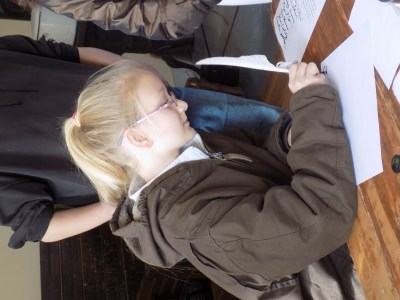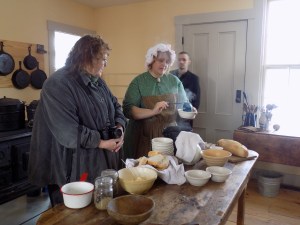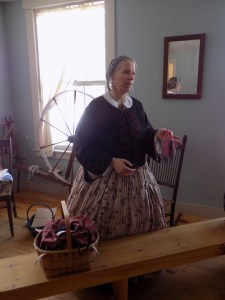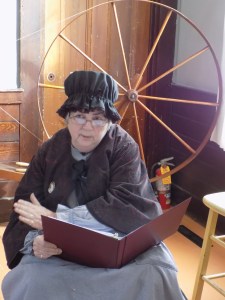LIVERMORE — At a “Cabin Fever Reliever” fundraising event at the Washburn-Norlands Living History Center on Saturday, people of today learned about those from the past.
The Norlands, as it is known locally, is Maine’s oldest living history farm and museum. It relies on volunteers who portray real people from 19th-century Maine. They become immersed in their characters and demonstrate the use of implements from that era.
One character, “Antoinette Fuller,” talked about the men in her family cutting ice from the nearby pond and storing it in the icehouse, as Kristy Drouin of Auburn listened attentively.
Fuller was played by Carolyn Lawson who is a trustee for the Living History Center. She took a few minutes to explain that there is currently no icehouse at the Norlands, but one will be part of the new barn that will be built this year. She also talked about the barn rebuilding efforts and how those interested could, for $25, purchase a peg that will be used in the new barn.
Later, director Sherri Leahan said there is a limited time for the pegs to be sold. The name of the purchaser, a name in memory of or to honor someone, may be written on the peg. Another option is to have a favorite quote printed on the peg. Leahan will take a picture to note the sponsorship. Pegs can be purchased at the Norlands or online by visiting www.norlands.org.
Fuller also showed some of the fancy work she had sewn, including a crocheted miser’s purse. She explained the reason for the two sides of the purse. Shops were often dark. Copper coins were kept in one part of the purse with silver ones in the other. She could tell by feel which ones were which.
Carole Works of Winslow was in character as “Sarah Bowles.” She had cloth bags with items used in earlier times and was asking guests to determine what each item was, what it would have been used for and where on the property it would have been found. A whetstone, a soap saver, a sock darner, a cream skimmer, an ox shoe and a pot scrubber made of interconnecting metal loops were easily identified by some but were more challenging to others.
The widow Howard, who was also known as “Aunt Clara,” was played by Willi Irish. She has been volunteering at the Norlands since March 31, 1976, and is the longest-serving volunteer at the center. She read excerpts from journals written by one of the Washburn sons and Osca Bigelow Pratt, a Fayette resident of that time.
Irish noted that the ladies of the day talked of the weather and what their husbands were doing before writing about their day. Men spoke only of the weather and their activities.
“Aunt Clara” read, “There was a deep pull among the aged … the mails have come the last month at a rate of about once a week …Tippling Mary is gone and the whiskey is holding out better.” She explained a pull was a conversation, that people missed regular mail deliveries in the colder months and that Mary was a kitchen helper.
“Aunt Clara” also spoke of the winter school term ending and that there were no spring or fall terms. The fall was harvest time and all hands were needed to bring in the crops to make it through the winter. Mud season and the lack of paved roads made it difficult to hold classes in the spring.
In the schoolhouse, “Miss Weld” was keeping the wood stove warm. Portrayed by Colleen Swanson, the widow relied on the $1.50 weekly pay.
“Miss Weld” teaches young ladies how to curtsy and boys the proper way to bow. She stresses the importance of looking people in the eye and showing manners when entering or leaving a room.
“Esther Weld” was a true abolitionist and one of the first women in Maine to run a political meeting. She was a member of the Peru group First Daughters of Freedom. She is included in the book “Women of Maine” written by Lee Agger.
Swanson, who was a school nurse in Peru, likes helping dispel or dispute the image that rural education was bad. “People underestimate the arithmetic problems and quality of reading that was asked for,” she said.




Comments are no longer available on this story